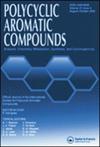3-(2-(2,4-二甲基苯基)腙)-6-氟喹啉-(1H, 3H)- 2,4-二酮E/Z异构化反应的合成、表征及研究
IF 2.6
3区 化学
Q2 CHEMISTRY, ORGANIC
引用次数: 0
摘要
合成了化合物6-氟-4-羟基喹啉-2(1H)- 1(1),并与重氮化的2,4 -二甲基苯胺在碱性介质中反应,得到深黄色结晶化合物的腙衍生物(2)。通过FT-IR, 1D和2D NMR以及质谱分析证实了纯化产物的结构。结果表明,产物完全采用腙结构,在溶液中以E和Z几何异构体的平衡混合物存在。在B3LYP/6-311++G (d, p)水平上的DFT量子计算表明,化合物(2)的腙形式比偶氮结构更稳定,其中z -腙异构体的总能量最低。此外,对腙化合物(2)在不同极性溶剂中的E和Z异构体的紫外-可见光谱研究表明,E异构体在非极性溶剂中占主导地位。本文章由计算机程序翻译,如有差异,请以英文原文为准。
Synthesis, Characterization and Study of E/Z Isomerization in 3-(2-(2,4-Dimethylphenyl) Hydrazono)-6-Fluoroquinolin-(1H, 3H)-2, 4-Dione
The compound 6-fluoro-4-hydroxyquinolin-2(1H)-one (1) was synthesized and reacted with diazotized 2, 4-dimethylaniline in a basic medium, yielding the hydrazone derivative (2) as a deep yellow crystalline compound. The structure of the purified product was confirmed through FT-IR, 1D and 2D NMR, and mass spectroscopic analyses. The results showed that the product exclusively adopts a hydrazone structure, existing as an equilibrium mixture of E and Z geometrical isomers in solution. DFT quantum calculations at the B3LYP/6-311++G (d, p) level indicated that the hydrazone form of compound (2) is more stable than the proposed azo structure, with the Z-hydrazone isomer having the lowest total energy. Additionally, UV-Vis spectroscopy studies of the E and Z isomers of hydrazone compound (2) in solvents of varying polarities showed that the E isomer is the predominant species in non-polar solvents.
求助全文
通过发布文献求助,成功后即可免费获取论文全文。
去求助
来源期刊

Polycyclic Aromatic Compounds
化学-有机化学
CiteScore
3.70
自引率
20.80%
发文量
412
审稿时长
3 months
期刊介绍:
The purpose of Polycyclic Aromatic Compounds is to provide an international and interdisciplinary forum for all aspects of research related to polycyclic aromatic compounds (PAC). Topics range from fundamental research in chemistry (including synthetic and theoretical chemistry) and physics (including astrophysics), as well as thermodynamics, spectroscopy, analytical methods, and biology to applied studies in environmental science, biochemistry, toxicology, and industry. Polycyclic Aromatic Compounds has an outstanding Editorial Board and offers a rapid and efficient peer review process, as well as a flexible open access policy.
 求助内容:
求助内容: 应助结果提醒方式:
应助结果提醒方式:


